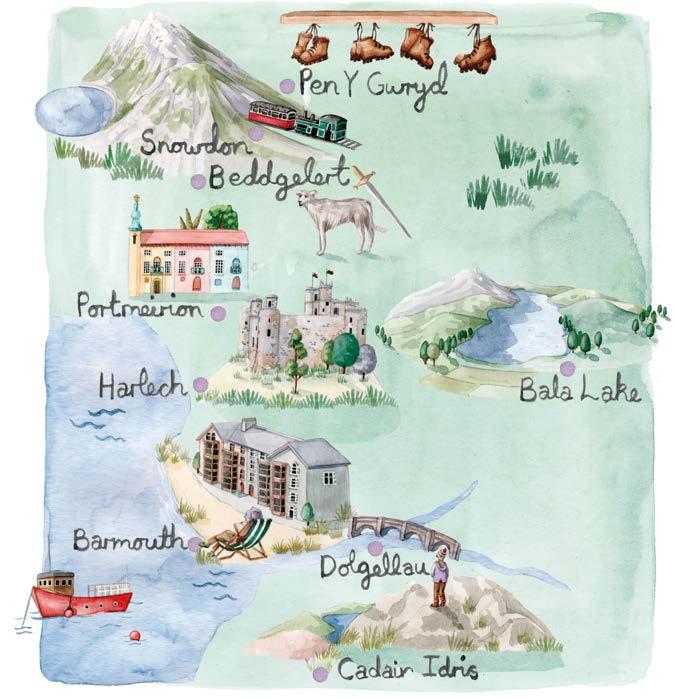








































With ancient towns, lost ports and timeless villages, the low-lying eastern county of Norfolk is steeped in history
 WORDS LAURENCE MITCHELL
WORDS LAURENCE MITCHELL











for his new wife in 1762, became their favourite abode. Fourteen of their fteen children were born there.
But what might seem like a blissful existence, combining love with every luxury, was not entirely so for Charlotte. An affectionate marriage meant she found herself pregnant more or less continuously for over two decades. No ‘prisoner could wish more ardently for his liberty,’ she once complained.
Similarly, her royal duties provided little scope for intellectual stimulation. The clever Charlotte – privately ‘of the opinion that if women had the same advantages as men in their education they might do as well’ – often reported boredom and frustration. Her status was also
socially isolating. Involvement in politics was rmly discouraged by George, as was the forming of close friendships with aristocratic ladies, which might be construed as political bias.
Of course, the greatest trial of her life was the King’s mental illness, now thought by many scholars to be the result of bipolar disorder. His rst serious episode in 1788 was shattering for Charlotte. She had to watch her sleepless, violent and incessantly chattering husband con ned by doctors; her distress compounded by unexpected humiliation. During his derangement, the King was prone, in front of various courtiers, to make unmistakably amorous remarks about her lady-in-waiting, the Countess of Pembroke, whom he called his true wife. In lewd language he would accuse Charlotte of adultery. Often he treated her with intense hostility, once gloating that he loved their dogs more than her. It shocked observers who had been more used to witnessing the King’s spontaneous displays of affection towards his wife.
The experience changed Charlotte. Her hair turned white. She became reluctant to spend time alone with George, increasingly living a separate life – especially after his progressively more violent bouts of illness in 1801 and 1804 – and locking her door against him at night. She became depressed and bad-tempered, particularly towards her unmarried daughters, who themselves resented being kept closeted away from society, especially after George’s most serious relapse in 1810, after which he was largely a recluse.
But Charlotte deserves to be remembered for far more than her misfortunes. Not only was she a champion for her husband – controlling the sensitive information released about his health, encouraging loyalty to the absent King and protecting his political interests – but in charitable terms, she was a champion of her female subjects. She was patron of both the rst maternity hospital and the Magdalen, a refuge for ‘penitent’

In his derangement, the King was prone, in front of courtiers, to make unmistakably amorous remarks about Charlotte’s lady-in-waiting
With more than 11,000 miles of coastline and around 7,000 islands, seeing the British Isles from the water is an experience not to be missed. Read on for our pick of the cruises showcasing the wealth of history, nature and scenery along our shores
 WORDS SARA MACEFIELD
WORDS SARA MACEFIELD
If you want to get under the skin of the UK’s home nations, jump aboard this cruise that circumnavigates the country. From Scotland’s legends of Loch Ness and the spirit of Robert the Bruce at Urquhart Castle near Invergordon to the Viking heritage of Stornoway in the Outer Hebrides, the Caledonian spirit comes alive. Dip into the colourful back story of Belfast at the city’s excellent Titanic Museum or step out on to the geological wonder that is the Giant’s Causeway. There’s also a chance to explore the self-governing kingdom of the Isle of Man (left), home of the famous TT motorbike race, and trot along the seafront promenade of its capital Douglas in a horse-drawn tram.
Saga Cruises offers a 10-night Hidden Gems of the British Isles round-trip voyage from Tilbury, also calling at the Scilly Isles and Scottish port of Oban. Departing on August 11, it costs from £3,862pp. travel.saga.co.uk/cruises

Wales has a strong storytelling tradition, and every schoolchild knows by heart the tales told in a medieval tome called The Mabinogion. Many of these myths and legends are linked to the towering mountains and shimmering lakes of Snowdonia in North Wales, where every hill, lake and village seems to have a tale of giants, knights and dragons in its dim and distant past.

Snowdonia’s mythical allure has bewitched visitors for centuries: after the Norman invasion of Britain, various princes of Wales evaded capture by escaping to the mists of Snowdonia, never to be seen again.
It is not hard to lose yourself here. Craggy peaks are blanketed in Welsh oak and mountain ash, plunging to lush river gorges, churning waterfalls and vast green valleys. Looming above it all is Snowdon, the tallest mountain in Britain outside Scotland. Snowdon dominates the horizon at the north end of Snowdonia, but even in the south of the park the scenery is never short of spectacular.
The few buildings that punctuate the 823 square miles of dramatic landscape only serve to magnify its beauty: dry stone walls clinging to steep hillsides, ancient clapper bridges that cross gurgling streams, slate-roofed villages huddled against mountain slopes. Best of all, ruined abbeys and mighty castles cast their own romantic spell.
Many of these castles were the work of Edward I in the late 13th century, who, alarmed by the unruliness of his Welsh subjects, built an ‘Iron Ring’ of fortresses across North Wales to keep them in check. The mightiest of them all is just outside Snowdonia’s northern boundary.

A masterpiece of medieval architecture, Caernarfon took 47 years to build, and as an unashamed show of royal power, it remains unparalleled. Its vast curtain walls and imposing King’s Gate were designed to intimidate the Welsh natives, while its polygonal towers, eagle statues and multicoloured stone echo the architecture of imperial Rome. Local legends also come into play: the location on the banks of the River Seiont recalls the Welsh myth of Macsen Wledig, who dreamed of a great fort at the mouth of a river – ‘the fairest that man ever saw’.
From beneath the castle walls you can take the historic Welsh Highland Railway to reach the slopes of Mount Snowdon itself, steeped in local lore. King Arthur reputedly slew the mountain’s most famous resident, Rhitta, a fearsome giant who created a cape for himself out of the beards of his enemies.
You can take another historic train – the Snowdon Mountain Railway – all the way to the summit (where Arthur’s knights supposedly covered the giant’s corpse with huge boulders). It is one of the world’s most scenic rail journeys and the only rack-and-pinion railway in Britain, which carried its rst passengers in 1896. This May, services will reach the summit for the rst time since 2019 and the visitor centre will reopen, where you can admire the staggering views of the sheep-dotted valleys far below, and send a postcard from the summit postbox.

Previous page: Snowdon is the highest mountain in Wales and England This page, clockwise from above: Caernarfon Castle was built in 1283; pretty Dolgellau; the boots of the 1953 Mount Everest team at the Pen-y-Gwryd Hotel; the Snowdon Mountain Railway
Hardy types ascend Snowdon on foot (a not-so-gentle round trip of 5–7 hours), most via the Llanberis Path. Many walkers stay at an old roadside inn at the foot of Snowdon, the Pen-y-Gwryd Hotel, which was used as the training headquarters for the rst successful ascent of Everest in 1953. When the landlord received the news by phone at 1am that the mountaineers had reached the summit, he apparently woke up all of his guests, telling them that if they didn’t assemble in the bar within ten minutes for a celebratory glass of champagne they would be thrown out.
The team held reunions at the Pen-y-Gwryd for decades and it remains a place of pilgrimage for mountaineers the world over. Meals are still announced by a gong, and the Smoke Room is full of memorabilia of Edmund Hillary and Tenzing Norgay, including ice picks, crampons, boots and a string vest.

A short but scenic drive south, the stone-built village


You can take the historic Snowdon Mountain Railway all the way to the summit, where King Arthur is said to have slain a giant
Boasting not only the most complete city walls in Britain, but also the oldest racecourse, the largest Roman amphitheatre and England’s oldest shopfront, the ancient city of Chester would be a tough one to beat on a history-themed Top Trumps card. Despite being a relatively small city compared to its neighbouring northern counterparts, Manchester and Liverpool, Chester’s historic beauty and lively atmosphere bring it to life in a unique way, making it a delightful destination for a city break.
cities in England to fall after their conquest of Britain in 1066, William I created the rst Earl of Chester who began the construction of Chester Castle in 1070.

Chester’s history dates back to Roman times. Founded as a fort in 79 AD, its large harbour and imposing city walls made it one of the most important settlements of the time. Even now, the city is dotted with evidence of its Roman inhabitants, which often crops up in the most unexpected of places.
Under the rule of the Anglo-Saxons, Chester faced two great invasions; the rst from the Vikings in 865, who sailed up the River Dee in their longships to wreak havoc. The Normans came next, and though it was one of the last
In the Middle Ages the city thrived as a trading port and its famous medieval shopping streets of galleried shops, known as the Rows, were built. After a rocky period during the English Civil War when the city was besieged for two years and the population was starved out until it surrendered, Georgian times saw elegant new houses built to house the wealthy merchants. The city then boomed during the Victorian age, when many handsome buildings sprung up; Grade II* listed Chester Town Hall is a ne example.
In fact, it’s the city’s wide array of architecture that makes it so appealing and attractive. A Norman cathedral reigns supreme alongside ancient Roman ruins, medieval shops and graceful Georgian townhouses. Yet it’s far from a museum piece: with raucous racegoers and keen shoppers descending to enjoy the delights of modern-day entertainment, this is a lively, bustling place for a city break.
Every chapter of this ancient city’s two thousand years of history is etched into its walls, but it’s a haven for the modern traveller too
WORDS HENRIETTA EASTON
Norman cathedral reigns supreme alongside ancient Roman ruins, medieval shops and graceful Georgian townhouses